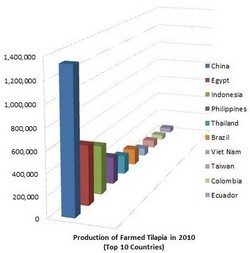
<!--
<!--<!--[if gte mso 10]> <style> /* Style Definitions */ table.MsoNormalTable {mso-style-name:"جدول عادي"; mso-tstyle-rowband-size:0; mso-tstyle-colband-size:0; mso-style-noshow:yes; mso-style-parent:""; mso-padding-alt:0cm 5.4pt 0cm 5.4pt; mso-para-margin:0cm; mso-para-margin-bottom:.0001pt; mso-pagination:widow-orphan; font-size:10.0pt; font-family:"Times New Roman"; mso-ansi-language:#0400; mso-fareast-language:#0400; mso-bidi-language:#0400;} </style> <![endif]-->
Tilapia Production Continues Upward
Tilapia is one of the most widely produced food fishes. Tilapia is farmed or harvested from wild populations in over 75 countries. This fish group has been widely recognized as an important food source in Asia and Africa for over 50 years, where until recently most of it was consumed locally. However, in the last two decades, there has been greater consumer acceptance of tilapia in North America and Europe and tilapia is now an important food source in these regions. Much of the tilapia consumed in North America and Europe is imported from Asia, the Middle East, and South America.
Tilapia is second to carp as the most popularly farmed fish. In 1994 worldwide production of farmed tilapia was 500,000 metric tons. By 2002 over 1.5 million metric tons of tilapia were produced. Production accelerated to almost 3.5 million metric tons by 2010.
China is the largest producer of tilapia farming 1,331,890 metric tons in 2010. This is over twice as much as Egypt (557,049 mt) and Indonesia (458,752 mt). As the chart shows, the majority of tilapia production takes place in Asia (China, Indonesia, Philippines, Thailand, Viet Nam, Taiwan), the Middle East (Egypt) and South America (Brazil, Columbia, Ecuador). By comparison, very little tilapia is produced in North America and the United States production was 9,979 mt in 2010.
Dr. Kevin Fitzsimmons, a professor at the University of Arizona an noted tilapia expert, predicts that tilapia will surpass carp and become the most important aquaculture fish in the 21st century. Tilapia has a number of unique characteristics which favor its rise in popularity as an aquaculture species. These characteristics include high growth rate, ability to subsist on natural food sources, reproductive capability, and ability to tolerate a range of environments. Ongoing breeding programs now produce tilapia with faster growth rates and better fillet yield. Tilapia can be grown in high density and in polyculture systems with shrimp and other fish.
<!--
<!--<!--[if gte mso 10]> <style> /* Style Definitions */ table.MsoNormalTable {mso-style-name:"جدول عادي"; mso-tstyle-rowband-size:0; mso-tstyle-colband-size:0; mso-style-noshow:yes; mso-style-parent:""; mso-padding-alt:0cm 5.4pt 0cm 5.4pt; mso-para-margin:0cm; mso-para-margin-bottom:.0001pt; mso-pagination:widow-orphan; font-size:10.0pt; font-family:"Times New Roman"; mso-ansi-language:#0400; mso-fareast-language:#0400; mso-bidi-language:#0400;} </style> <![endif]-->
يمكن متابعة اخر أخبار المزارع السمكية و السمك و الدخول فىى حوار مع افراد مجموعة (المزارع السمكية Aquacultures)على الفيس بوك و كنانة او لاين:
http://kenanaonline.com/hatmheet
http://www.facebook.com/groups/210540498958655/


ساحة النقاش